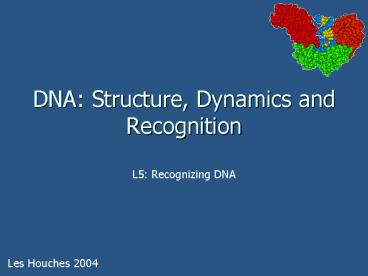DNA: Structure, Dynamics and Recognition - PowerPoint PPT Presentation
Title:
DNA: Structure, Dynamics and Recognition
Description:
DNA: Structure, Dynamics and Recognition – PowerPoint PPT presentation
Number of Views:106
Avg rating:3.0/5.0
Title: DNA: Structure, Dynamics and Recognition
1
DNA Structure, Dynamics and Recognition
L5 Recognizing DNA
Les Houches 2004
2
DNA-BINDING LIGANDS
3
DNA-binding ligand famillies
- Covalent
- Intercalators
- Groove binding
- Coordination
4
Covalent Binding Ligands
Nitrogen mustard
Mitomycin
Anthramycin
Acetylaminofluorene
Psoralen
Sibiromycin
5
Anthramycin
- binds to a guanine amino group in the minor
groove
6
Intercalators
9-Aminoacridine
Proflavine
Ethidium
Acridine orange
7
Proflavine
8
Daunomycin
- leukemia therapy
9
Ditercalinium
- a bisintercalator - inhibits DNA repair
10
Groove binding ligands
Distamycin
Netropsin
Hoechst 33258
11
Netropsin complex with DNA
- minor groove - AT specific
12
DNA-binding ligand "kits"
Linkers
Rings
Ends
13
NMR structure of 21 complex of distamycin
14
Linked polyamide ligands
Cyclic
H-pin
Hairpin
15
Polyamide 2-1DNA complex
ImImPyPy-b-Dp
16
Inhibition of gene transcription using polyamides
17
Cl
NH3
Pt
Cl
NH3
- shielding from excision repair
Coordination ligands cisPt
http//web.mit.edu/chemistry/lippardlab/lab.html
18
DNA-BINDING PROTEINS
19
DNA binding families
- Transcription factors (CAP, 434, Cro, )
- Architectural (histones, HMG, )
- Enzymatic (nucleases, methyltransferases, )
- Replication factors
- Repair enzymes
20
- ?-helices generally interact with the major
groove of B-DNA (12Å wide), while ?-sheets can
bind to the minor groove (6Å wide) - Protein binding to DNA often deforms the double
helix (bending, untwisting, ...). Base pairing is
usually not destroyed, but major structural
changes can occur - Complexes are stabilized by arginine or lysine
side chains binding to the DNA phosphate groups
(salt bridges)
General features
21
"Direct" versus "Indirect"
- DIRECT RECOGNITION
- Formation of hydrogen bonds between
- between the amino acid side chains of the
protein and the DNA bases - INDIRECT RECOGNITION
- Detection of sequence dependent changes in DNA
structure or flexibility (bending, twisting,
groove opening, )
22
Switching genes on and off in phages
23
Induce lysogenic or lytic phase
24
Transcriptosome
25
DNA bound to TBPTF11ATF11B
26
Transcription factors often have a modular
structure
NH3
COO
-
27
RECOGNITION MECHANISMS
28
Coding with four bases A, C, G, T
29
Energetics
Stabilising factors Hydrogen bonding (base-aa,
backbone-aa) Partial stacking (aromatic side
chains) Salt bridges (phos-arg/lys) Ion
release Solvation entropy Destabilising
factors DNA / protein deformation DNA /
protein entropy Solvation enthalpy
30
Recognizing base pairs
31
Recognition major versus minor groove
32
Recognition sites in the major groove
33
HELIX-TURN-HELIX MOTIF
34
HTH characteristics
Prokaryotes - homodimers - bind to palindromic
sequences - contact DNA through recognition helix
(RH) - orientation of RH can vary significantly
Eukaryotes - monomers - bind to non-palindromic
sequences - orientation of RH less variable
35
DNA binding domain (DBD) 434 repressor
8-4-8 aa
Recognition helicies
Dimerisationdomain
36
Different dimerisation domains
Cro
l repressor
37
DNA binding 434 repressor, HTH motif
38
DNA binding 434 Cro, HTH motif
39
Position of the recognition helices
HTH RMSD 0.6 Å
40
CAP dimer
DBD
ATP cofactor
Activation domain
Dimerisation domain
41
CAP dimer bound to DNA
50 of curvature
42
trp repressor cofactor binding control
43
trp repressor
Recognizes ACTAGTTAACTAGT No direct H-bonds to
bases Several water bridged bonds
44
Engineering HTH protein specificity
45
Eukaryote ? Prokaryote
Long recognition helix
Homeodomain l repressor Trp
repressor
Monomeric
Dimeric
46
Engrailed homeodomain
47
ZINC FINGERS
48
C2/H2 zinc finger composition
30 aa Largest eukaryote family Monomeric with
repeated fingers - TF111A 9, Sp1 3
C2/H2 consensus
-Tyr/Phe-X-Cys-X2-4-Cys-X-Tyr/Phe-X5-Leu-X2-His-X3
-4-His-
49
Zif268 3 fingers bound to 10 bp
b-hairpin / turn / a-helix
3 bp per finger
2xCys 2xHis
50
C4 zinc finger composition
Homo- or heterodimers Nuclear receptors
(progesterone, estrogen, )
C4 consensus
-Cys-X2-Cys-X13-Cys-X2-Cys-X15-Cys-X5-Cys-X9-Cys-X
2-Cys-
51
Glucocorticoid Receptor
4xCys
52
Hormones regulate gene expression
53
Gal4 - binuclear zinc cluster
1.5 turns
6xCys
54
LEUCINE ZIPPERS
55
Leucine zipper hydrophobic stabilisation
56
GCN4 (bZIP) basic leucine zipper
½ turn
57
Max (b-HLH-Zip) helix-loop-helix
58
b-SHEETS
59
Met repressor
Anti-parallel b-sheet
60
Met repressor - b-sheet in major groove
61
IHF-DNA complex
62
TATA BOX BINDING PROTEIN
63
Tata-box binding protein (TBP)
b-sheet in minor groove
64
TBP-DNA complex
65
Sex determining Region on chromosome Y
HMG box (3 a-helices) b-sheet in minor groove DNA
bending (70) to initiate transcription,
66
A WORD ON PROTEIN INDUCED BENDING
67
Bending and transcription
68
Nucleosome schematic view
69
Nucleosome dinucleotide distributions
70
Alex Rich asymmetric neutralisation
Mirzabekov and Rich PNAS 76, 1979, 1118
71
Jim Maher bending by neutralisation
Strauss and Maher, Science 266, 1994, 1829
72
ENZYMATIC PROTEINS
73
Hha I methyltransferase
74
EcoRI endonuclease
Recognises GAATTC
75
Action of EcoRI
76
Cutting DNA with restriction enzymes
77
Crystal Form IV of EcoRV DNA complexHorton
Perona, PNAS, 97, 5729 (2000)
78
Conformation change in EcoRV
Apo
Non-specific
Specific






























